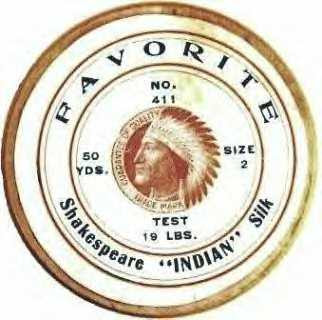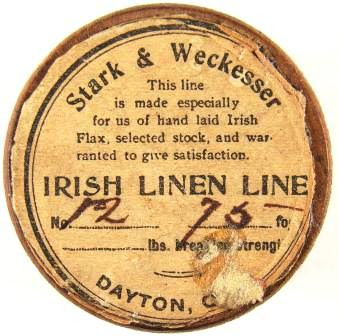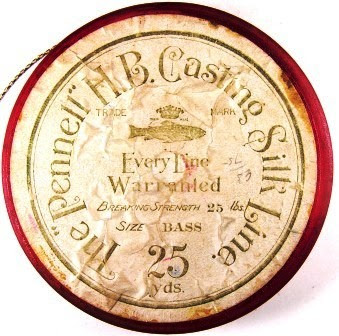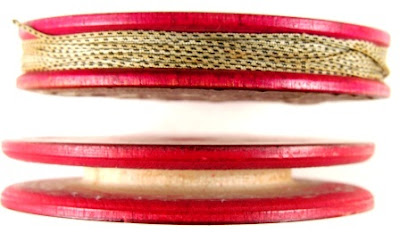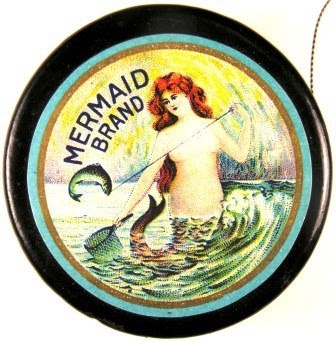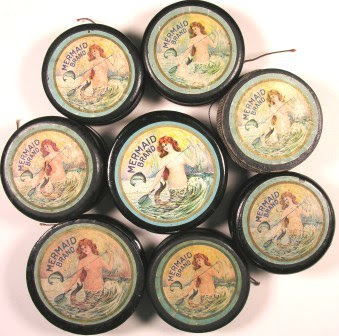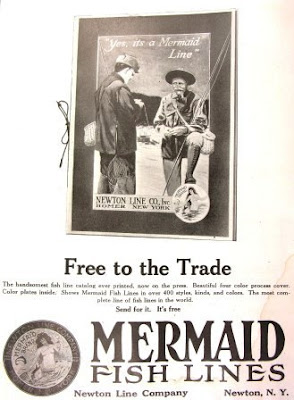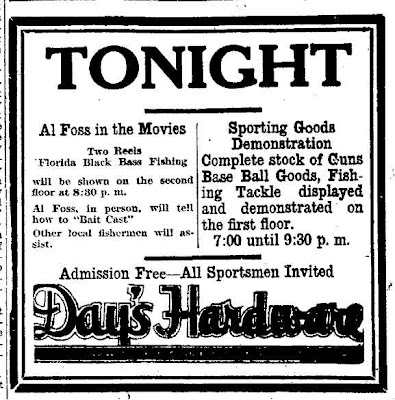 First version with printer's flourish beneath the word waterproof and with Large size letters used in the words HARD BRAID SILK - 1900 to 1931.
First version with printer's flourish beneath the word waterproof and with Large size letters used in the words HARD BRAID SILK - 1900 to 1931..
.
In 1816 John Gladding, who was a 7th generation member of the original Gladding family that had immigrated to America from England 140 years earlier, started a new cordage business in Pharsalia, New York making ropes, chalk lines, and fish lines.
 Second version with printer's flourish discontinued and Made In U S A added in its place beneath the word waterproof and with Large size letters used in the words HARD BRAID SILK introduced in 1932.
Second version with printer's flourish discontinued and Made In U S A added in its place beneath the word waterproof and with Large size letters used in the words HARD BRAID SILK introduced in 1932. Third version with By Gladding added above Trade Mark and with Medium size letters used in the words HARD BRAID SILK - introduced in 1934.
Third version with By Gladding added above Trade Mark and with Medium size letters used in the words HARD BRAID SILK - introduced in 1934.By definition, Invincible, means "incapable of being overcome or subdued," as in an "Invincible Army" or "Her invincible spirit." As it was used by Gladding, the brand name "The Invincible" was intended to connote a fishing line that was incapable of being overcome or subdued by water, which was most appropriate for what was to become known as the "World’s first waterproofed silk casting line."
 Fourth Version with Made in U S A reduced to outer edge of label; Test and Yards added in its place, and with Small size letters used in the words HARD BRAID SILK - introduced in 1938.
Fourth Version with Made in U S A reduced to outer edge of label; Test and Yards added in its place, and with Small size letters used in the words HARD BRAID SILK - introduced in 1938..
.
The history of the creation of this remarkable fishing line actually began well before 1900. "The Invincible" line was created over a period of several years under the leadership of B. F. Gladding, for whom the Gladding family business had been renamed after he took over as head of the company in 1878.
 The first "Musky" Line version of "The Invincible" line was introduced about 1924 - it had all of the same features as the 1909 first version of "The Invincible" silk casting line except for the words "Musky" Line which replaced the words Casting Line on the labels.
The first "Musky" Line version of "The Invincible" line was introduced about 1924 - it had all of the same features as the 1909 first version of "The Invincible" silk casting line except for the words "Musky" Line which replaced the words Casting Line on the labels.
.
B. F. Gladding had installed a new hand turned braider in 1878, eventually adding ten more and then subsequently using horse and sweep for the power source to operate these fishing line braiders. By 1890, Gladding had moved the factory from Pharsalia to South Otselic New York where he built a dam on the river there and installed a water wheel to power 50 additional new braiders. To operate these new braiders the number of employees was increased to 19, of which 9 were Gladding family members.
Gladding, had made only linen and cotton lines since its founding in 1816, but by 1895 they had begun to make silk lines too. B. F. Gladding selected what was considered to be the very best Japan silks that could be obtained to use in manufacturing his new braided silk fishing lines.
 The First Box used for The Invincible was a simple white two piece cardboard box with gold trim around the top edge. There are two different versions of this box. One was used from 1900 to 1911 and the other one was used from 1912 - 1933. If you have one of these boxes, you may contact me for help in determining which version that you have.
The First Box used for The Invincible was a simple white two piece cardboard box with gold trim around the top edge. There are two different versions of this box. One was used from 1900 to 1911 and the other one was used from 1912 - 1933. If you have one of these boxes, you may contact me for help in determining which version that you have.Gladding acquired his silk from the Nonotuck Silk Company which had been established in 1835, and which had produced the famous Corticelli silk sewing threads. These silk threads had won several World's Fair Awards, and had produced the first and only silk threads of a consistent diameter and quality that could successfully be used on Isaac Singer's new invention - the sewing machine - without the threads jamming the machine as was the case with all other competitor's silk threads. By combining Gladding's many years of braiding experience with the much superior quality imported Japan silks from the Corticelli Silk Mills, the creation of "The Invincible" was close to being realized
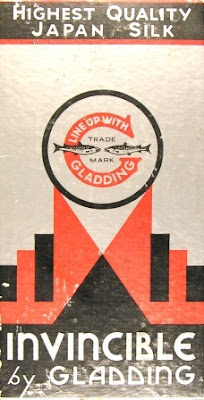 The Second Box used for The Invincible was of a modern Art Deco style design with bright silver, red and black colors. This second box had the words "Highest Quality Japan Silk" printed at the top and was offered only from 1934 through 1936.
The Second Box used for The Invincible was of a modern Art Deco style design with bright silver, red and black colors. This second box had the words "Highest Quality Japan Silk" printed at the top and was offered only from 1934 through 1936.By 1897 Gladding hired a Mr. Shields from Boston to spend several months teaching his employees the secret Scottish process for enameling fishing lines. Three additional years of research, experimentation and testing of the enameling process, eventually led Gladding to discover a more thorough waterproofing process that not only treated the surface of the silk fishing lines but treated the individual threads within the silk line too. It was this formula (which remained a closely guarded secret of the Gladding firm for more than 50 years) that was finally used to create the World's first "Waterproofed" silk casting line - “The Invincible"
 The Third Box used for The Invincible was also the modern Art Deco style design with bright silver, red and black colors; however, it had a modification to the logo and the words printed at the top of the box were changed to read "Best Japan Silk". This version of the box was offered for only one year - 1937 - and it was then changed again the following year. This was also the last year for the version three labels that are shown with this very rare one year box.
The Third Box used for The Invincible was also the modern Art Deco style design with bright silver, red and black colors; however, it had a modification to the logo and the words printed at the top of the box were changed to read "Best Japan Silk". This version of the box was offered for only one year - 1937 - and it was then changed again the following year. This was also the last year for the version three labels that are shown with this very rare one year box."The Invincible" brand offers collectors of vintage fishing tackle an opportunity to find several different rare and historic labels and package variations of their Japan Silk Casting Lines that were manufactured from 1900 to 1941. Collectors, who are observant and know what to look for, can easily distinguish the nuances and clues that indicate the specific year or specific time periods that their particular spools of "The Invincible" Silk Casting lines were made. As a general rule, knowing whether the age of a fishing line is 100 years old or 50 years old is important, because it can make a very big difference in its rarity, as well as in its historic significance and collector value.
 The Fourth Box used for The Invincible was a standard two piece card board box in orange color with the company logo stamped in black at an angled pattern across the entire surface of the lid. It was introduced in 1938 and is not a very common box to find since it was used for only that one year.
The Fourth Box used for The Invincible was a standard two piece card board box in orange color with the company logo stamped in black at an angled pattern across the entire surface of the lid. It was introduced in 1938 and is not a very common box to find since it was used for only that one year.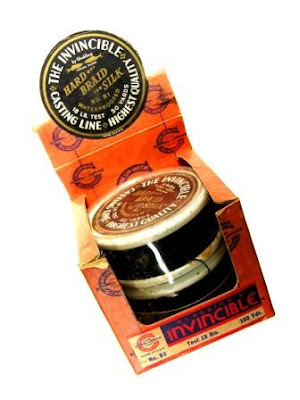 The Fifth Box used for The Invincible was introduced in 1939 and it included a counter top display feature. The spools that came inside this box were also packed inside of a revolutionary new plastic cylindrical container that was much like today's modern plastic bubble packaging. With this innovative packaging, Gladding was almost two decades ahead of everyone else in the use of plastics for packaging. This combination counter top display box with the plastic packages was offered for only two years from 1938 through 1939, and while they are quite popular with collectors, they are not easy to find today
The Fifth Box used for The Invincible was introduced in 1939 and it included a counter top display feature. The spools that came inside this box were also packed inside of a revolutionary new plastic cylindrical container that was much like today's modern plastic bubble packaging. With this innovative packaging, Gladding was almost two decades ahead of everyone else in the use of plastics for packaging. This combination counter top display box with the plastic packages was offered for only two years from 1938 through 1939, and while they are quite popular with collectors, they are not easy to find today The Sixth Box used for The Invincible was a simple yellow color box identified only by an end label. It was introduced in 1940 and continued to be used throughout 1941 until America's entry into World War II. Following the Japanese bombing of Pearl Harbor on December 7, 1941, the practice of selling any Japan Silk Lines (like The Invincible) to American fishermen was immediately discontinued. This was due in part to the political sentiments of the times, but it was far more due to the embargo on Japanese Silk imports that Franklin Roosevelt had signed as a Presidential order just a few months prior to the bombing of Pearl Harbor.
The Sixth Box used for The Invincible was a simple yellow color box identified only by an end label. It was introduced in 1940 and continued to be used throughout 1941 until America's entry into World War II. Following the Japanese bombing of Pearl Harbor on December 7, 1941, the practice of selling any Japan Silk Lines (like The Invincible) to American fishermen was immediately discontinued. This was due in part to the political sentiments of the times, but it was far more due to the embargo on Japanese Silk imports that Franklin Roosevelt had signed as a Presidential order just a few months prior to the bombing of Pearl Harbor.